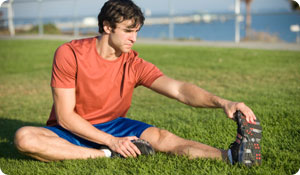
Despite what you may have heard, real men do stretch. This misunderstood exercise provides several health and fitness benefits. However, research and guidelines about stretching are often conflicting, leaving many men confused about whether to include it in their fitness routine or not. In short, you should and here's why:
1. Stretching increases strength. A study published in Medicine & Science in Sports & Exercise, the journal of the American College of Sports Medicine (ACSM) found that stretching can increase the amount of weight you lift or press, the number of repetitions you can do, and muscle endurance.
2. Stretching increases range of motion. Several studies confirm that stretches promote greater flexibility, a physical asset you lose as you get older. Stretching helps to relax muscles and joint tissues, which allows for better body mechanics during your workout, sports, and possibly during day-to-day activities.
3. Stretching reduces injury. While there's still debate about whether stretching before exercise or sports prevents injuries, there's more agreement that there is a definite benefit after physical activities. According to the Mayo Clinic, aerobic and strength-building exercises make muscles contract and flex. Stretching helps to relax muscles. After physical activity is an ideal time to do it because your muscles are warm and pliable. Also, the ACSM states that flexibility is an essential part of long term injury prevention.
4. Stretching promotes joint health. Greater flexibility is also a bonus for your joints. For your joints to perform at their best, they need good range of motion. Also, whether you do intense or moderate workouts, you put extra pressure and stress on your joints. Stretching helps to keep tendons and ligaments flexible and to keep joints properly aligned.
5. Stretching helps muscles recover. Another benefit of stretching is that it increases blood circulation to the muscles, which promotes better recovery from injury - an unfortunate but common occurrence for many men during exercise or sports.
Types of Stretches
There are three types of stretching exercises health professionals recommend:
- Static - the most common types of stretches where you extend a muscle until you feel mild discomfort, such as calf or hamstring stretches.
- Dynamic- stretches that move your limbs through a particular motion, for example swinging your arms across your body, or toe-touching exercises with opposite arms.
- PNF - PNF stands for proprioceptive neuromuscular facilitation, exercises that are performed with a partner who moves your body in certain ways to stretch and contract various muscle groups.
Basic Stretching Guidelines
The ACSM recommends performing stretching exercises or flexibility training at least two to three days a week. Never subject cold muscles to static or PNF stretches--always warm up first, or do it after your workout. Do not bounce during stretches (ballistic stretching); it increases your risk of injury. Also, stop stretching if you feel pain.
In terms of how long you should hold a stretch, some newer recommendations suggest that the length of time should vary for each muscle group; however, more research is needed to confirm this. For now, the ACSM advises holding each stretch for 10 to 30 seconds. For a PNF stretch, contract for six seconds, then follow it with a 10- to 30-second assisted stretch.
Sources
The American College of Sports Medicine, Mayo Clinic, American Association of Orthopaedic Surgeons, the Stretching Institute, University of Tennessee Medical Center
Physician and Sportsmedicine 2000, Vol. 28 No. 8, pp. 57-63. "Myths and Truths of Stretching: Individualized Recommendations for Healthy Muscles." Ian Shrier, MD, PhD; Kav Gossal, MD. http://prevost.pascal.free.fr/public/pdf/Shrier2000.pdf





